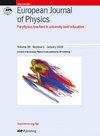增强现实技术在物理教学中的应用:机遇与挑战的系统回顾
IF 0.8
4区 教育学
Q4 EDUCATION, SCIENTIFIC DISCIPLINES
引用次数: 0
摘要
使用增强现实技术(AR)可以将数字信息整合到我们对物理世界的感知中。在本文中,我们全面回顾了以前发表的关于在中小学和大学物理教育中实施增强现实技术的文献。我们的综述包括对 Scopus 和 Eric 数据库中 96 篇论文的分析,这些论文均发表于 2012 年 1 月 1 日至 2023 年 1 月 1 日之间。我们评估了 AR 如何用于促进物理学习。我们总结了不同物理主题中潜在的基于 AR 的学习活动,并报告了与基于 AR 的物理学习相关的机遇和挑战。研究表明,AR 技术可以通过以下方式促进物理学习:提供补充可视化、优化认知负荷、允许触觉学习、减少任务完成时间以及促进合作探究。在物理教学中使用 AR 的潜在缺点主要与软硬件技术的缺陷(如相机冻结、可视化延迟)和无关的认知负荷(如更多关注次要细节而非构建目标知识)有关。本文章由计算机程序翻译,如有差异,请以英文原文为准。
Augmented Reality Technology in Teaching about Physics: A systematic review of opportunities and challenges
The use of augmented reality (AR) allows for the integration of digital information onto our perception of the physical world. In this article, we present a comprehensive review of previously published literature on the implementation of augmented reality in physics education, at the school and the university level. Our review includes an analysis of 96 papers from the Scopus and Eric databases, all of which were published between January 1st, 2012 and January 1st, 2023. We evaluated how AR has been used for facilitating learning about physics. Potential AR-based learning activities for different physics topics have been summarized and opportunities, as well as challenges associated with AR-based learning of physics have been reported. It has been shown that AR technologies may facilitate physics learning by: providing complementary visualizations, optimizing cognitive load, allowing for haptic learning, reducing task completion time and promoting collaborative inquiry. The potential disadvantages of using AR in physics teaching are mainly related to the shortcomings of software and hardware technologies (e.g., camera freeze, visualization delay) and extraneous cognitive load (e.g., paying more attention to secondary details than to constructing target knowledge).
求助全文
通过发布文献求助,成功后即可免费获取论文全文。
去求助
来源期刊

European Journal of Physics
物理-物理:综合
CiteScore
1.70
自引率
28.60%
发文量
128
审稿时长
3-8 weeks
期刊介绍:
European Journal of Physics is a journal of the European Physical Society and its primary mission is to assist in maintaining and improving the standard of taught physics in universities and other institutes of higher education.
Authors submitting articles must indicate the usefulness of their material to physics education and make clear the level of readership (undergraduate or graduate) for which the article is intended. Submissions that omit this information or which, in the publisher''s opinion, do not contribute to the above mission will not be considered for publication.
To this end, we welcome articles that provide original insights and aim to enhance learning in one or more areas of physics. They should normally include at least one of the following:
Explanations of how contemporary research can inform the understanding of physics at university level: for example, a survey of a research field at a level accessible to students, explaining how it illustrates some general principles.
Original insights into the derivation of results. These should be of some general interest, consisting of more than corrections to textbooks.
Descriptions of novel laboratory exercises illustrating new techniques of general interest. Those based on relatively inexpensive equipment are especially welcome.
Articles of a scholarly or reflective nature that are aimed to be of interest to, and at a level appropriate for, physics students or recent graduates.
Descriptions of successful and original student projects, experimental, theoretical or computational.
Discussions of the history, philosophy and epistemology of physics, at a level accessible to physics students and teachers.
Reports of new developments in physics curricula and the techniques for teaching physics.
Physics Education Research reports: articles that provide original experimental and/or theoretical research contributions that directly relate to the teaching and learning of university-level physics.
 求助内容:
求助内容: 应助结果提醒方式:
应助结果提醒方式:


